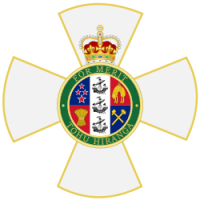Difference between revisions of "New Zealand Order of Merit"
(Created page with "New Zealand Order of Merit The New Zealand Order of Merit, begun in 1996, recognizes outstanding New Zealand citizens who have made remarka...") |
|||
| (10 intermediate revisions by the same user not shown) | |||
| Line 1: | Line 1: | ||
| − | [[File:nzom. | + | [[File:nzom.png|200px|thumb|left|New Zealand Order of Merit]] |
| − | The New Zealand Order of Merit, begun in 1996, recognizes outstanding New Zealand citizens who have made remarkable contributions in their designated profession for the country. There are five categories of awards: | + | The New Zealand Order of Merit, begun in 1996, recognizes outstanding New Zealand citizens who have made remarkable contributions in their designated profession for the country. The Order of Merit represents the country's highest civilian honour, and the presentations are made at the beginning of each New Year. The motto for the order is 'For Merit' or 'TOHU HIRANGA' in Maori (to achieve excellence). |
| + | |||
| + | The motto is set in green enamel which alludes to the highly prized pounamu or New Zealand greenstone (nephrite). The breast star is based on the head or crown of the ponga or silver fern tree (cyathea dealbata). It is regarded as a national emblem of New Zealand. The fern frond, in particular the silver fern frond, is to New Zealand what the oak leaves are to England and the laurel leaves to the world at large, i.e. the symbol of the champion, the winner or the achiever. The collar provides a blend of both English and Maori cultures and alludes to the ancient origins of both, in particular the concept of chivalry. The koru is found in many forms in Maori art and is a stylised representation of a fern frond. It may symbolise new birth, growth, vitality, strength and achievement. The earliest known English collars were composed of the letter “S” and the design of the koru is based on this letter. | ||
| + | |||
| + | There are five categories of awards: | ||
* Knight or Dame Grand Companion (GNZM) | * Knight or Dame Grand Companion (GNZM) | ||
| Line 11: | Line 15: | ||
We have identified several LGBTQ individuals who have been honoured with the award: | We have identified several LGBTQ individuals who have been honoured with the award: | ||
| + | * [[Georgina Beyer]], politician | ||
* [[Gareth Farr]], Composer | * [[Gareth Farr]], Composer | ||
* [[Peter Gordon]], Chef | * [[Peter Gordon]], Chef | ||
| + | * [[Jacqui Grant]], transgender activist | ||
* [[Witi Tame Ihimaera-Smiler]], Writer | * [[Witi Tame Ihimaera-Smiler]], Writer | ||
| + | * [[Michael Parmenter]], Dancer and choreographer | ||
* [[Marilyn Waring]], Former Member of Parliament | * [[Marilyn Waring]], Former Member of Parliament | ||
* [[Peter Wells]], Filmmaker and writer | * [[Peter Wells]], Filmmaker and writer | ||
| Line 22: | Line 29: | ||
* [[Order of Australia]] | * [[Order of Australia]] | ||
* [[Order of Canada]] | * [[Order of Canada]] | ||
| + | * [[LGBTQ Recipients of the Order of Merit]] | ||
| + | * [[LGBTQ Recipients of the Presidential Medal of Freedom]] | ||
| + | * [[LGBTQ Individuals Who Have Received France's Highest Honours]] | ||
| + | * [[LGBTQ Members of the Order of Orange-Nassau]] | ||
| + | * [[Nobel Prize Winners from the LGBTQ Community]] | ||
==Further Reading/Research== | ==Further Reading/Research== | ||
Latest revision as of 01:31, 1 September 2024
The New Zealand Order of Merit, begun in 1996, recognizes outstanding New Zealand citizens who have made remarkable contributions in their designated profession for the country. The Order of Merit represents the country's highest civilian honour, and the presentations are made at the beginning of each New Year. The motto for the order is 'For Merit' or 'TOHU HIRANGA' in Maori (to achieve excellence).
The motto is set in green enamel which alludes to the highly prized pounamu or New Zealand greenstone (nephrite). The breast star is based on the head or crown of the ponga or silver fern tree (cyathea dealbata). It is regarded as a national emblem of New Zealand. The fern frond, in particular the silver fern frond, is to New Zealand what the oak leaves are to England and the laurel leaves to the world at large, i.e. the symbol of the champion, the winner or the achiever. The collar provides a blend of both English and Maori cultures and alludes to the ancient origins of both, in particular the concept of chivalry. The koru is found in many forms in Maori art and is a stylised representation of a fern frond. It may symbolise new birth, growth, vitality, strength and achievement. The earliest known English collars were composed of the letter “S” and the design of the koru is based on this letter.
There are five categories of awards:
- Knight or Dame Grand Companion (GNZM)
- Knight or Dame Companion (KNZM/DNZM)
- Companion (CNZM)
- Officer (ONZM)
- Member (MNZM)
We have identified several LGBTQ individuals who have been honoured with the award:
- Georgina Beyer, politician
- Gareth Farr, Composer
- Peter Gordon, Chef
- Jacqui Grant, transgender activist
- Witi Tame Ihimaera-Smiler, Writer
- Michael Parmenter, Dancer and choreographer
- Marilyn Waring, Former Member of Parliament
- Peter Wells, Filmmaker and writer
- Douglas Wright, Dancer and poet
See Also
- Order of Australia
- Order of Canada
- LGBTQ Recipients of the Order of Merit
- LGBTQ Recipients of the Presidential Medal of Freedom
- LGBTQ Individuals Who Have Received France's Highest Honours
- LGBTQ Members of the Order of Orange-Nassau
- Nobel Prize Winners from the LGBTQ Community

